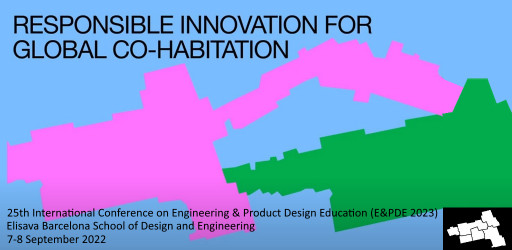REORIENTING DESIGN THINKING THROUGH SYSTEMS THINKING
Harsaae, Malene Pilgaard; Nielsen, Martin Storkholm; Østergaard, Thomas; Bang, Anne Louise
Type:
Year:
2023
Editor:
Buck, Lyndon; Grierson, Hilary; Bohemia, Erik
Author:
Series:
E&PDE
Institution:
VIA University College, Denmark; Center for Creative Industries & Professions – VIA University College, Denmark
Section:
Responsible innovation in design and engineering education
DOI number:
ISBN:
978-1-912254-19-4
Abstract:
Although Design thinking originated as a process to solve wicked problems such as environmental issues and inequality (Rittel and Webber, 1973: Buchanan, 1992), the approach tends to focus on a conventional linear growth paradigm rather than a sustainable transition with nature at the core. Design thinking arose in a time (mid 90s - 00s) when climate and environment did not receive the same attention as in recent years. We believe that Design thinking still has its justification as a process tool, however, the authors are convinced that the tool can be strengthened if we focus more on materials and early use of prototyping, and if the process is supplemented with a consistent focus on natural interdependencies and systems thinking. We will address and discuss this as a perspective to re-balance the Design thinking process in the current context, where natural recovery and green transition should be highest priority. Design thinking emphasizes research as the first step of defining a relevant problem. This can typically be in the form of ‘empathizing’ (Ideo, Stanford), ‘discovering’ (Double Diamond, British Design Council) or ‘finding’ (5F, VIA University College). That is, with a human-centered focus. In this paper, we discuss ways in which systems thinking can serve as an entrance point to a re-balanced Design thinking process model with nature in the center. In two projects we have employed systems thinking at different phases in the design thinking process. One project has used systems thinking throughout the whole process with an intensified focus on the solution. The other project has used system thinking specifically in the initial phases to find and re-frame the problem through system mapping. The focus in the paper is to evaluate in which ways and to what extent system thinking has contributed to the process. In this paper we use interviews with participating students from both projects as a foundation for our discussions. The projects are respectively an internal project with local students and an external project with multiple international partner universities and students. We present the two projects, the participating students, and the partners involved together with the insights from the interviews. The local project Design for Change is a three-week project with 48 students from the 5th semester specialty ‘Entrepreneurship and Innovation’. The GPA Map the System is a 10-week long learning experience offered in collaboration between Humber College, Otago Polytechnic and VIA University College for students to build key competencies for sustainable development (Rieckmann, Mindt and Gardiner, 2017) through activities focused on systems thinking and mapping. Systems thinking allows us to reorient our thinking from being entity-focused (a product, a local problem, a specific person) to include multiple entities (products and services, multiple problems, multiple stakeholders), their interrelations, the dynamics of the system, and very importantly the different scales of the system (Hunt, 2020) Based on the insights from the two projects, this paper discuss the didactic approaches to system thinking, the potentials and challenges in connecting it to design thinking processes and summarize with recommendations.
Keywords:





